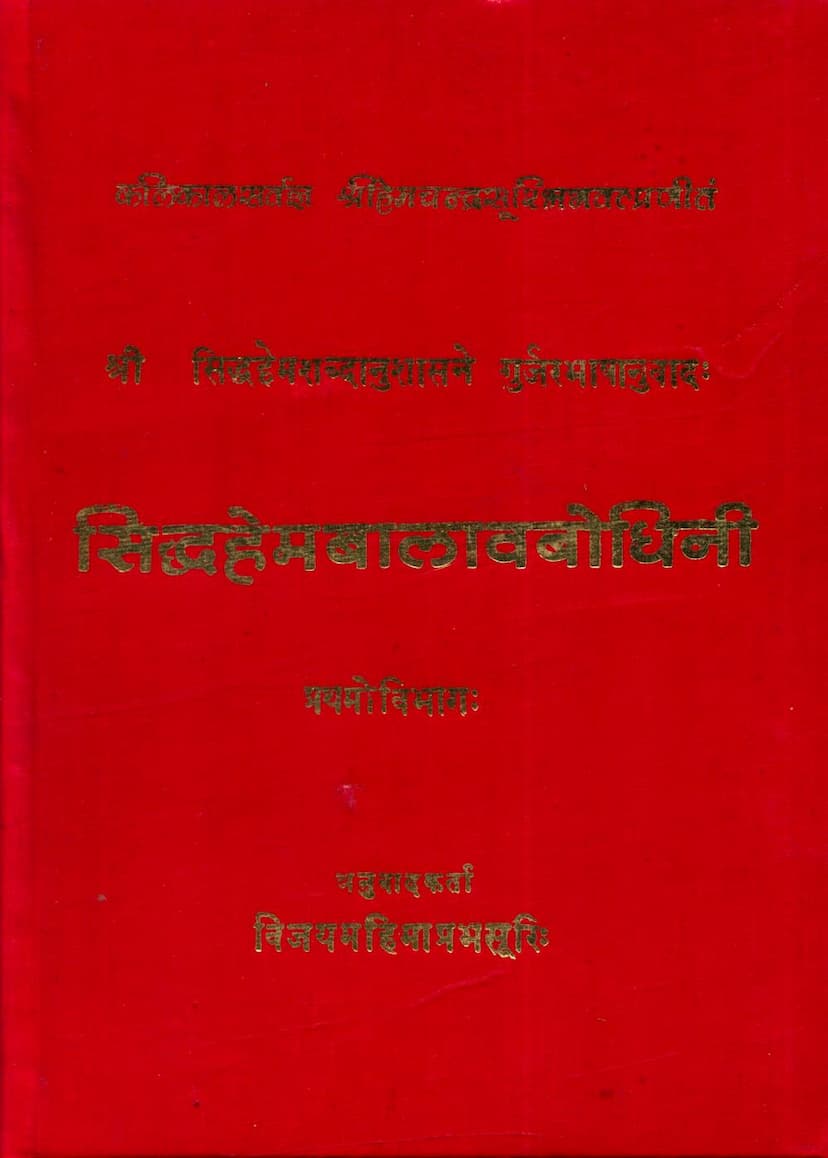Siddhhem Balavbodhini Part 01
Added to library: September 2, 2025

Summary
Based on the provided text, here is a comprehensive summary of "Siddhhem Balavbodhini Part 01" in English:
Book Title: Siddhhem Balavbodhini Part 01 Author: Mahimaprabhsuri Publisher: Mahimaprabhvijay Gyanmandir Trust
Core Content and Purpose:
This book, "Siddhhem Balavbodhini Part 01," is a Gujarati translation and commentary on the foundational Jain Sanskrit grammar text, Siddhhem Shabdanushasanam, authored by the esteemed Maharaj Shri Hemchandrasuri. The primary purpose of "Balavbodhini" (meaning "understanding for children" or "simplified explanation for beginners") is to make the complex Sanskrit grammar of Hemchandrasuri accessible and understandable to a wider audience, particularly students beginning their study of grammar.
Key Features and Structure (Based on the provided pages):
-
Sanskrit Foundation: The book is based on the Siddhhem Shabdanushasanam, a monumental work in Sanskrit grammar, often considered the most comprehensive grammar of its time. Hemchandrasuri's work covers not only Sanskrit but also Prakrit grammar.
-
Gujarati Translation and Explanation: The core of "Balavbodhini" is the Gujarati translation and detailed explanation of Hemchandrasuri's Sanskrit verses (sutras). This ensures that the meaning and rules of grammar are conveyed in a more accessible language.
-
Target Audience: As the title suggests, it is aimed at beginners or students ("Balavbodhini") who need a simplified and clear exposition of the grammar.
-
Content of Part 01: The first part of "Balavbodhini" covers the "Aakhyat Prakaran" (आख्यातप्रकरण), which deals with verb conjugations and related grammatical concepts. The provided index (Anukramanika) and the text itself show a progression through various sections of grammar, starting from:
- Sanjna Prakaranam (संज्ञाप्रकरणम्): Sections dealing with grammatical terms and definitions (e.g., vowel, consonant, pada, avyaya).
- Sandhi Prakaranam (सन्धिप्रकरणम्): Rules of euphonic combination.
- It seems to cover the initial parts of grammar, including sections on: Pronouns (Purvadhyae), Declensions (Namas), Case endings (Vibhakti), Compound words (Samasa), and the beginning of verb conjugations (Aakhyat Prakaran).
-
Authorship and Guidance:
- The primary author of the Gujarati translation and explanation is Mahimaprabhsuri, the successor to Acharya Vijaynemisurishwarji.
- The work is inspired and guided by Acharya Bhagwant Shrimad Vijaynemisurishwarji Maharaj, a prominent figure in the Tapa Gachchha tradition.
- Muniraj Shri Vivek Vijayji Maharaj is mentioned as a motivating assistant.
-
Publisher and Distribution: The book is published by Shri Vijaymahaprabh Suri Gyanmandir Trust, located in Ahmedabad, India.
-
Emphasis on Clarity: The preface (Prastavik) highlights the progressive nature of Jain scholarship, with various scholars making contributions. It emphasizes that this work is designed to be easy to understand, offering simple meanings for sutras, analysis of examples, and explanations in Gujarati.
-
Historical Context: The preface also touches upon the rich literary heritage within the Jain tradition, mentioning the vast collection of palm-leaf manuscripts and copper-plate inscriptions preserved in the trust's library, which spans not only Jain literature but also non-Jain works.
-
Theological Significance: The importance of grammar is underscored as a path to understanding truth, leading to ultimate liberation (Moksha). The text begins with a reverential salutation to the Tirthankar and the foundational texts.
Summary of the Provided Content (Pages 1-498+):
The provided text is a significant portion of the grammar book, covering several key sections. It meticulously explains the rules of Sanskrit grammar as laid down by Hemchandrasuri, in Gujarati. The explanations include:
- Definitions of grammatical terms (Sanja Prakaran): Identifying vowels, consonants, samjna (terms like 'it', 'gun', 'vriddhi'), root verbs (dhatu), suffixes, and parts of speech like noun (nama) and indeclinable (avyaya).
- Sandhi rules: Explaining how sounds change when words are combined.
- Pronouns: Detailing the forms of pronouns like 'idam' and 'adas'.
- Case System (Vibhakti): Explaining the eight cases (prathama, dvitiya, etc.) and their usage with nouns.
- Karak Prakaran (Karak): A detailed explanation of the six grammatical cases (Karta, Karma, Karan, Sampradan, Apadan, Adhikaran) and their rules, illustrating each with examples.
- Niyat Vidhan (Pattvidhan) and Natva Vidhan (Nadvidhan): Rules related to the changes of certain letters.
- Stri Pratyay Vidhan (Stripratyay Vidhan): Rules for forming feminine nouns.
- Samas Prakaranam (Samasa Prakaran): Rules for compound words.
- Aakhyat Prakaran (Aakhyat Prakaran): This is a major focus, covering verb conjugations, roots (dhatu), different tenses (vartaman, paroksha, hyastani, bhavishyati), moods (vidhi, aashir), verb types (atmanepadi, parasmai), and various euphonic changes (sandhi) that occur during verb formation. The book meticulously lists rules for specific verb roots and their behavior with prefixes and suffixes.
Overall Impression:
"Siddhhem Balavbodhini Part 01" appears to be a scholarly yet accessible work that aims to demysthify Sanskrit grammar for Gujarati-speaking students. It reflects a dedication to preserving and propagating the knowledge of classical Jain grammar, making it relevant and understandable for contemporary learners. The detailed explanations and numerous examples are characteristic of pedagogical texts designed for thorough learning. The involvement of respected Jain Acharyas highlights the spiritual and educational significance attached to this work within the Jain tradition.